There are eleven UNESCO World Heritage Sites in Belgium. If that surprises you, then you’ll be even more surprised when you read that the actual number of UNESCO sites in Belgium exceeds fifty. That’s because, even though the thirteen Flemish béguinages are spread out across Flanders, Belgium’s Dutch-speaking northern part, they count as only one world heritage site.
It’s the same with the 32 (!) Belgian belfries that dot the country. Despite being situated in 32 different cities or towns, they are considered to be just one UNESCO World Heritage Site, officially known as the “Belfries of Belgium and France”.
Belfries are unique to the northwestern European region that encompasses Belgium, northern France, and the southern Netherlands. Unlike in, for example, England, Germany, and Italy, medieval cities in this particular region chose to focus on building belfries, rather than city halls. They came to symbolize the power of autonomous cities, their prosperity, and their economic influence.
Contrary to city halls, a belfry used to have several purposes. Other than serving as the seat of the city council, it also served as a prison, kept the city charters and treasures, had a watchtower, and housed the communal bells.
Generally speaking, the cityscape of an old Belgian city features three major towers: the keep, which was the home of the lords; the bell tower, the symbol of the church; and the belfry, showcasing the influence of the local government. Sometimes the bell tower of a church was the city’s belfry, as is shown in a couple of examples below.
The following list of UNESCO World Heritage belfries in Belgium includes not only belfries but also a couple of church towers that, in addition to being significant religious buildings, served as alarm bell towers or watchtowers.
10 Impressive UNESCO World Heritage Belfries in Belgium
1. Belfry and Market Halls, Bruges
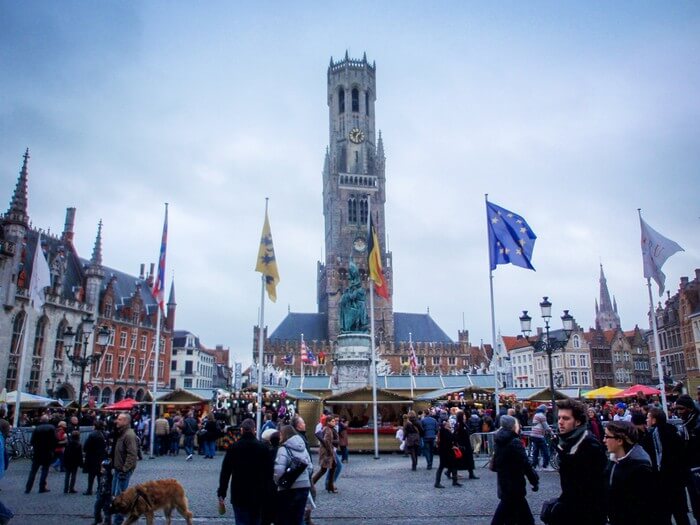
The Belfry and Market Hall of Bruges
The belfry in Bruges is the city’s most striking architectural feature. It dominates the medieval town square, which forms the heart of the historic city center of Bruges, a gorgeous city center that is also a UNESCO World Heritage Site.
The 83-meter-high belfry was used as a watchtower to spot dangers, such as oncoming storms, fires, and possible attacks. Now, after paying an entrance fee, people can climb the 366 steps to the top of the tower and enjoy absolutely spectacular panoramic views of the city. The belfry is open to the public every day of the week, from 9.30 a.m. to 5 p.m.
2. Cathedral of Our Lady, Antwerp
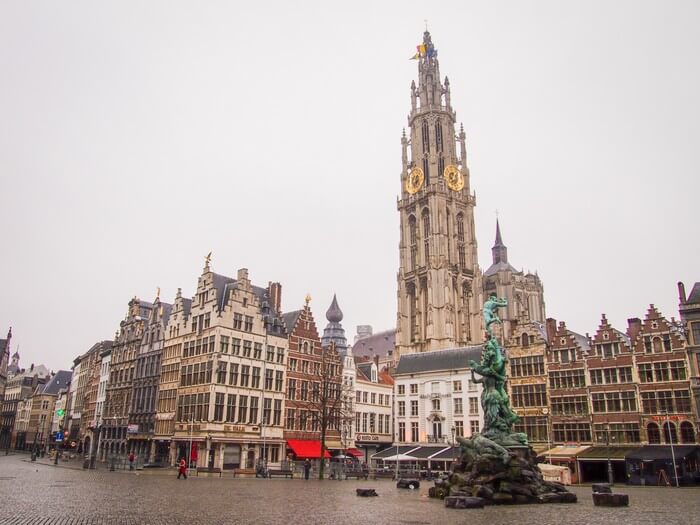
Cathedral of our Lady Antwerp
Technically not a belfry, but a church tower that also served as a watchtower, the Cathedral of Our Lady is one of the major attractions in Antwerp, Belgium’s second city. The church, however, was never completely finished.
Originally designed to have two imposing towers, only one of them has been completed. Nevertheless, reaching 123 meters toward the sky, that one tower is still the tallest church tower in the Benelux.
Inside the church, visitors can admire paintings by world-renowned Baroque artist Peter Paul Rubens, a former Antwerp resident.
3. Belfry and Cloth Hall, Ypres
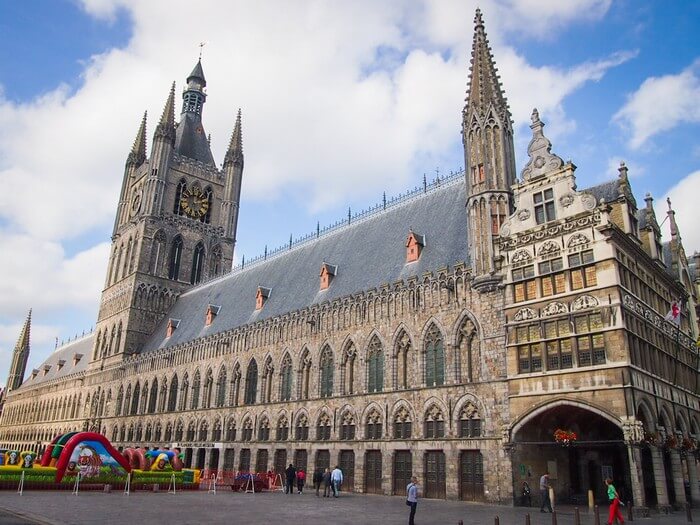
Belfry and Cloth Hall Ypres
In the Middle Ages, the cloth hall in Ypres was one of the biggest commercial structures in the world, providing space for the selling and distribution of cloth and fabrics – cloth making was a hugely lucrative business in Flanders at the time.
The building was constructed in the 13th century but was completely leveled during the First World War. After the war, it was reconstructed beautifully and now looks exactly like the former medieval building. Nowadays, the cloth hall houses the exquisite In Flanders Fields Museum that exhibits the history and horrors of World War I.
4. Belfry and Aldermen’s House, Aalst
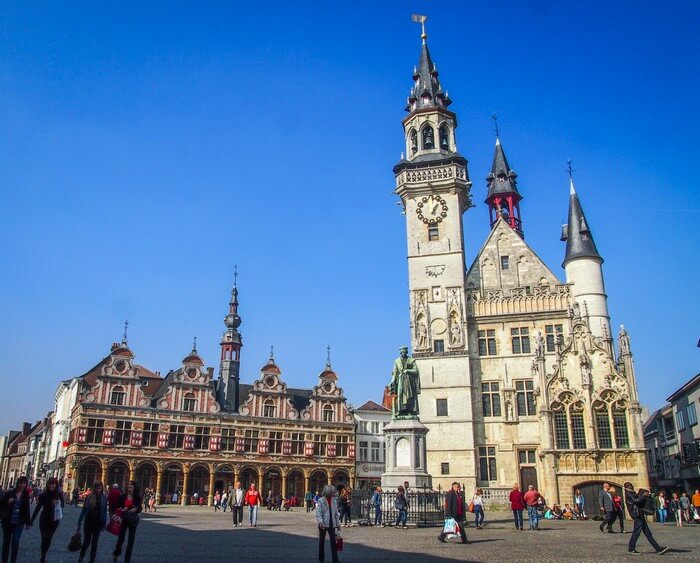
Belfry and Aldermen’s House Aalst
The Aldermen’s House in Aalst used to be the city hall and is, in fact, one of the oldest remaining city halls in Belgium and the Netherlands, dating back to 1225. It is a beautifully ornate structure, the appearance of which only improved with the addition of the belfry tower in 1460.
The combined structure now dominates the town square of Aalst, a rather quiet city that comes to life on the days before Ash Wednesday, when the Carnival of Aalst takes place. This three-day event features parades, processions, music performances, and street entertainment and, according to UNESCO, is a Masterpiece of the Oral and Intangible Heritage of Humanity.
5. Belfry, Namur
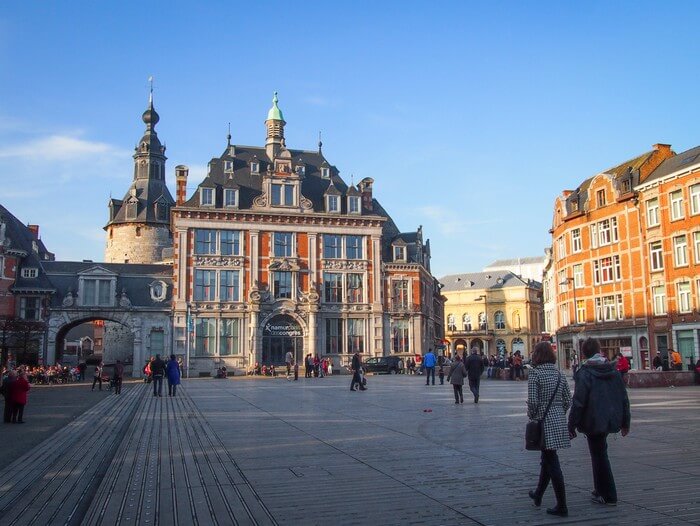
Belfry Namur
This historic building in the city center of Namur was built in the late 14th century and was originally a part of the fortified city walls. After the church of Namur, which also served as the belfry, was burned to the ground during a 1745 battle, the powerful tower became the belfry of the city.
Still protecting one of the main city gates, from then on, the tower and its bell would also warn the people of Namur of imminent danger.
6. Basilica of Our Lady and City Tower, Tongeren
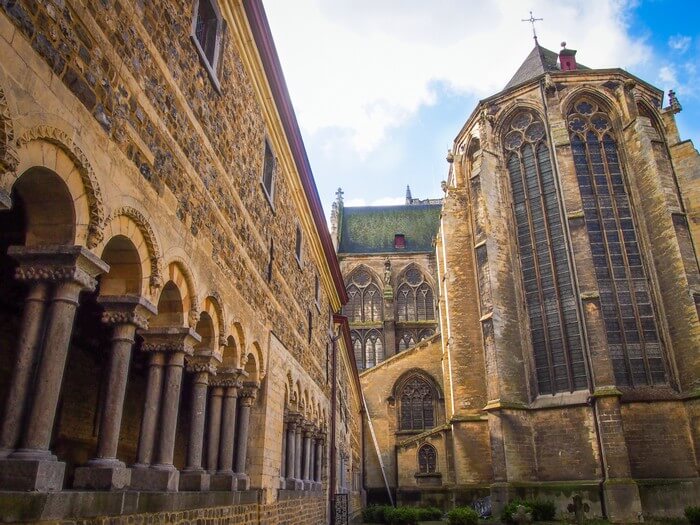
Basilica of Our Lady and City Tower Tongeren
The majestic bell tower of the Basilica of Our Lady is 64 meters high and overpowers all other buildings in the city center of Tongeren. Dating from the mid-16th century, this massive Gothic tower may just be one of the most imposing structures in Belgium.
Additionally, excavations underneath the basilica have unearthed several significant archeological artifacts while the building’s treasury holds one of Belgium’s most comprehensive collections of religious art.
7. Towers of the Saint Peter’s Church, Leuven
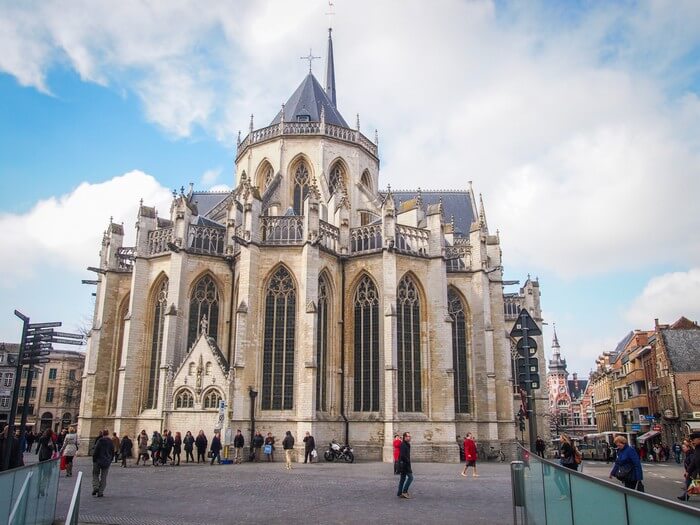
Leuven UNESCO Belfry at the St. Peter’s Church
Located right across the marvelous Gothic town hall of Leuven, arguably one of the most beautiful Gothic structures anywhere in the world, the huge Saint Peter’s Church was initially (in 1505, that is) meant to have three enormous towers; towers that would ambitiously rise 170 meters high, making it the tallest building in the world at the time.
For several reasons, the project was dropped, and, now, the central tower is only slightly taller than the roof of the church, while the two side towers are not even close to being finished.
Although they were never finished, the towers of the Saint Peter’s Church in Leuven are still a UNESCO World Heritage Site.
8. Saint Rumbold’s Cathedral Tower, Mechelen
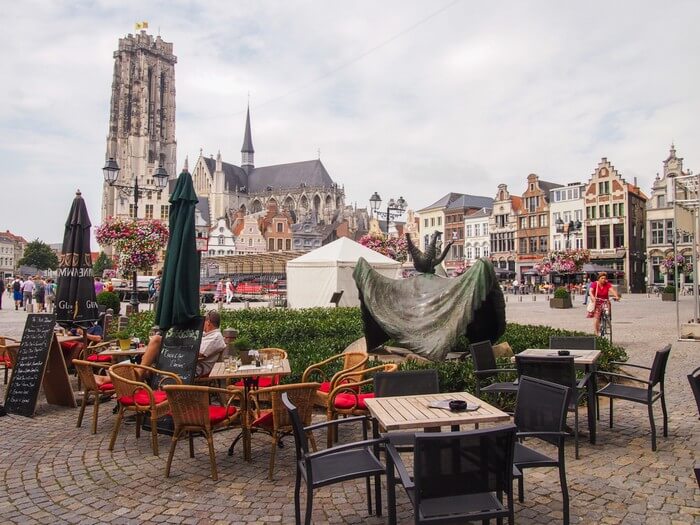
St. Rumbold’s Cathedral Mechelen
The Saint Rumbold’s Cathedral in Mechelen is the seat of the Roman Catholic Archbishop in Belgium or, in other words, the most significant church in the entire country. The church’s phenomenal tower is 97 meters high and served as a church tower, belfry, and city archive. The 514 stairs to the top can be climbed, a strenuous activity that’s done by many thousands of visitors each year.
A couple of facts to illustrate the significance of this tower and church: there are no less than 98 carillon bells; and people like Louis XV, Napoléon Bonaparte, and a few Belgian Kings and Queens have climbed its steps.
9. Belfry and City Hall, Lier
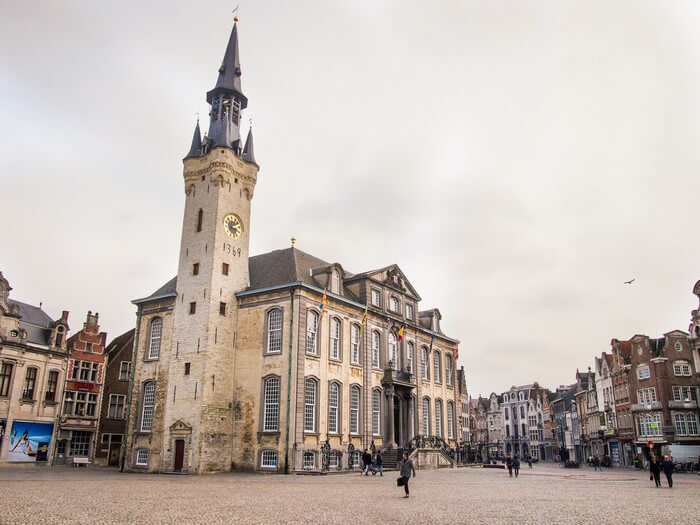
Belfry and City Hall Lier
The belfry and city hall stand proudly in the middle of the main square in Lier city. The belfry tower dates from 1369 and is the sole remainder of the city’s former cloth hall.
Like any other medieval city in Belgium, Lier’s economic autonomy and influence were shown in the building of this beautiful belfry. The city hall is much younger and was constructed in the mid-1700s. A beautiful Rococo building, it is still the seat of the city council and now houses the visitor center as well.
10. Belfry and Cloth Hall, Ghent
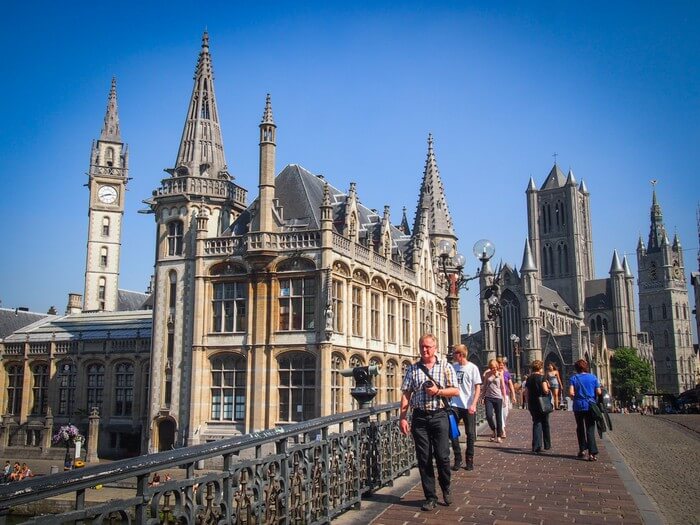
Ghent UNESCO Belfry and Cloth Hall
Ghent’s belfry tower was constructed in 1313 and has undergone several modifications and alterations up until 1913. With a height of 91 meters, it is one of the tallest belfries in Belgium and one of three prominent towers in Ghent.
The belfry has played an important role in the history of the city, announcing the time, warning of dangers, serving as a watchtower, and keeping many a valuable document. The cloth hall, which adjoins the belfry, was where the cloth trade took place in the Middle Ages. This was an economic activity that, just like Ypres, made Ghent a fabulously wealthy city.
(Sofie: I visited the Belfry in Ghent during a day trip there!)
Don’t forget travel insurance
Plan for the best, prepare for the worst. Travel insurance has you covered in case (part of) your trip gets canceled, you get sick or hurt abroad, and sometimes even when your electronics break or get stolen. I always make sure I’m covered every trip I go on.
Don’t have travel insurance yet? Check out SafetyWing. They offer super flexible plans that you can even sign up for while you’re already on your trip. On top of that, they were the first travel insurance to cover COVID, and when I got COVID, they reimbursed all of my expenses without making a fuss. Their customer support team is great and I can personally recommend them.
Bram is a freelance writer, translator, and travel photographer. He was born and grew up in a small town in Belgium and currently lives in a small town in Vermont, USA. He likes to try different travel styles and he has backpacked across Australia, cycled from Belgium to the North Cape and back, spent three months emerging himself in the Irish culture, hiked across England, climbed numerous mountains in New England, and visited many European cities. You can follow him at his blog Travel. Experience. Live.

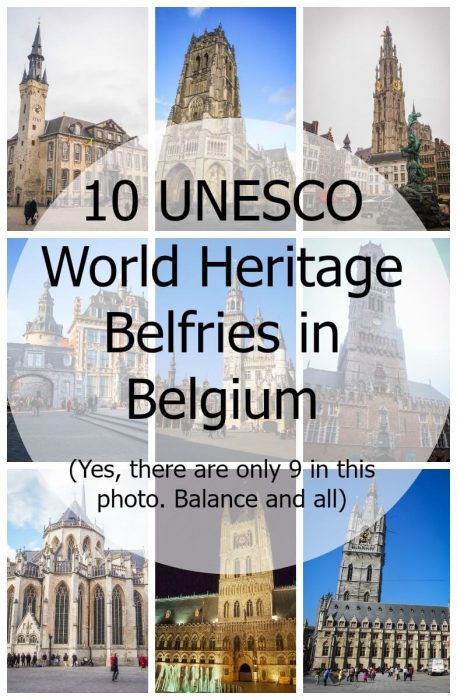
Corinne says
Sophie, Great post. I can’t wait to visit some of these Belgian cities I’ve yet to get to.
Sofie says
Thansk Corinne, but this was all Bram :)
Corinne says
I would love to go sea-kayaking in Sweden. It looks so peaceful and gorgeous.
Sofie says
Somehow I think this comment belongs with another post:D
Isabelle says
Northern France and the south of present-day Netherlands all belonged to Belgium in its history. And indeed, you say “this particular region” which is thus Belgium. Belgian Belfries. Are unique to Belgium. “Today partly located in present-day France and present-day Netherlands, that’s because Belgium in the past was a bigger country.”
Bram says
Thanks for commenting, Isabelle.
The country of Belgium, founded in 1830 after the Belgian Revolution, has never been larger than it is nowadays. If anything, it used to be even smaller, until the East Cantons were annexed from Germany after WWI.
Northern France and the southern Netherlands were never part of Belgium; it was the other way around. Historically, the region that is modern-day Belgium has been part of both France and the Netherlands (and a host of other countries). I agree with you that, culturally speaking, the region I mention in the post (northern France, Belgium and the southern Netherlands) could be considered homogenous. When it comes to geography, however, it is clearly divided, which is why I specifically distinguish between said three countries/regions.
This post talks about the belfries that are located within the boundaries of the country of Belgium. The UNESCO World Heritage Site also includes a few belfries in northern France, which could never be considered as a part of Belgium. I would always refer to those particular belfries as French belfries, definitely not Belgian belfries.
Isabelle says
Yes, they were part of Belgium and Belgium has never been smaller, that’s crazy what you’re saying! Also Belgium is not founded in 1830, but in 52 BC. You should listen to the words you are using and think. Thanks for your great post though, I learned something new about the Belgian Belfries, which are unique to Belgium, and thus also invented by Belgium! Today Belgian belfries are also located in present-day France and present-day Netherlands, as these territories belonged to Belgium. Bye, I wasn’t corrupted by separatism by living in Belgium, but can enjoy a healthy distance and independence, keeping oversight with a strong analytical viewpoint and power, while having deep insight knowledge and experience of Belgian culture as well, by living abroad. Also Belgium is Romanesque and the Netherlands is Germanic, in fact the Roman-Germanic cultural breach is situated in present-day Netherlands! Bye!
Bram says
Isabelle, if you’re referring to the ancient Roman province of Belgica, then you’re right. That area was, in fact, a lot bigger than present-day Belgium. However, Gallia Belgica existed a full millennium before the first belfry was even built. I don’t think we can use Roman regions and 2,000-year-old provincial borders as a reference to 21st-century geography can we?
Also, no self-respecting historian would ever dare to state that Belgium was founded in 52 BC. I would also like to point out that I refer to the ‘country of Belgium’ in my comment, which is without question founded in 1830. If we’re going to reconsider pre-Napoleonic borders, then Prague is still part of Austria, and the Ottomans rule Greece and the Balkans.
At the time of construction of the belfries, there was no Belgium. Instead, the region was ruled by a succession of different foreign powers. Many cities were, however, fairly independent and powerful. Hence, why they built belfries, as I’ve talked about in the post.
Therefore, I stick to my point: Belgian belfries are found in the country of Belgium, not in other countries. Again, this post only talks about belfries located within Belgian borders, so I think that the name Belgian belfries is appropriate.
Lastly, I always enjoy a good and healthy discussion, but I think that your remark on corruption by separatism is a bridge too far. I know you don’t know me at all, but if you’re implying that I am a separatist, you couldn’t be further from the truth. And, by the way, I live abroad too, which has made even more aware of Belgium’s issues and, most of all, strengths.
Joey says
Really helpful post! I’m heading to Belgium this summer and was planning a quick day trip to Bruges – though this makes me want to stop by the others!
Sofie says
Glad you like it, Joey. Thanks for commenting! So many cool places to check out in Belgium :-)